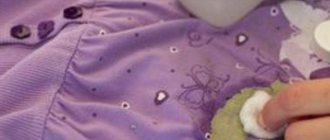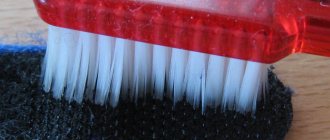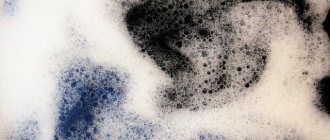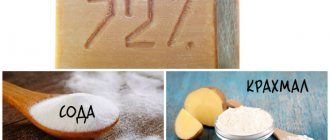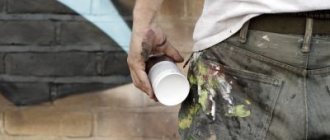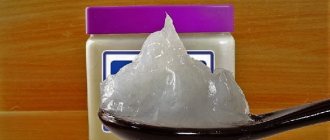You want to change clothes, mechanically grab the right thing from the closet and don’t understand what’s wrong with it. The clothes smell unpleasant, in some places the fabric is affected by black dots, as if from a fungus. Yes, the problem is the fungus and you urgently need to look for effective ways to get rid of mold in the closet.
If you don’t remove mold from your clothes as quickly as possible, the item will become irrevocably damaged, the fungus will spread to other items, and a small problem will turn into a disaster. Do not try to get rid of mold in the linen closet with half measures; the fight against fungus should be comprehensive.
Mold in the closet with clothes and bedding
Fungus is a common occurrence on wooden surfaces. When contacted with raw material, its spores quickly germinate in thin threads. The most favorable conditions for the appearance and spread of mold are considered to be: air temperature within 20 degrees, although some species can grow even at sub-zero temperatures, and high air humidity of 95%.
Consequences of high humidity in the house
The fungus affects cabinets, chests of drawers, and beds with niches for linen, if conditions favorable for its development arise. Mold invades:
- The back walls of cabinets, if the furniture is located close to the outer wall. In this case, fungus forms both on the outside and on the inside of the cabinets. The posterior wall from the outside is most often affected.
- The wall behind the cabinet, if it is external, is not additionally insulated.
- Corners of cabinets, both upper and lower.
- Space under cabinets if the home is located on the first floor in a house with a damp basement.
If there is a persistent, musty smell in the closet, but no mold was found, you can be sure that the fungus has settled on the wall behind the closet and that is where the specific stench is coming from.
Causes of mold formation in the closet
Before answering the question: how to get rid of mold, you need to know the main reasons for its occurrence. Only in this case will you be able to take adequate measures to completely eliminate the unpleasant odor and its source . The fungus is formed as a result of exposure to certain microorganisms that are quite dangerous to humans. On the surface it appears in the form of green, bluish or black spots; it multiplies quickly, affecting various materials, products and things.
Scheme of mold formation.
The causes of mold in the closet can be different. Most often, this is poorly dried laundry that is stored in it. But mold can also appear because it is already on the walls in the room. If there is constantly high humidity and low temperature in the room, then fungus will appear in it very quickly. This can often be observed in old multi-story buildings, where even the outer walls are contaminated with mold.
Typically in closets, mold can be found on the back wall, where it spreads to the shelves and linens. On bookcases, the presence of fungus is not immediately detected, since books are not used constantly. In this case, the stains are usually discovered after an unpleasant mold odor develops.
The reason for the smell in kitchen cabinets is that the kitchen area is constantly exposed to the negative effects of moisture: water often gets on the walls and shelves, and there is almost always dampness near the work area. If you do not carry out regular cleaning, then over time, pockets of mold will appear on all the furniture. In this case, the fight against it will last a very, very long time.
Causes of fungus in residential buildings
The normal humidity level for a comfortable life is within 70-80%. If there is a high level of humidity in your home, moisture begins to accumulate in a variety of places. It is in these places that the fungus appears, rapidly spreading over the entire surface of the walls, ceiling, furniture and clothing.
Dampness and humidity are the main causes of mold in the home. The following has an unfavorable effect on the indoor microclimate (increased humidity):
- Uneven heating of rooms, poor ventilation.
- Buildings without waterproofing, high thermal conductivity of corners.
- Heat loss in end rooms, increased area of external walls.
- The heating is turned off ahead of time and there is no rush to turn it on in the fall.
- Metal-plastic windows without microventilation mode.
- Low-power ventilation, especially in the kitchen and bathroom.
- Improper use of bathrooms.
- A large number of indoor plants, animals, an aquarium.
Why does mold grow on clothes?
- dampness in the room where the cabinet is located;
- arrangement of furniture in the corner of the room;
- storing wet clothes;
- spread through the washing machine if the fungus appears in it;
- lack of normal air circulation in furniture;
- the furniture is tightly closed and has no cracks, rarely opens;
- unwashed items are folded;
- old furniture with rotten areas.
Causes of mold in the kitchen
Mold, or household fungus, is an organism that multiplies extremely quickly. In the kitchen, it primarily occurs near the sink, in the windows or under the riser. If you notice this formation in yourself, try to clean it up immediately. Only a competent approach will prevent re-infection. Among the main causes of mold in the kitchen are the following factors:
- Poor ventilation, constant air stagnation.
- Poor heating, constant cold in the apartment.
- Having problems with heating.
- Freezing of walls - especially if the walls are on the outside of the house.
- Unsanitary conditions in the house.
Danger of mold to people
Learn more about why mold is harmful in an apartment or house. As it develops, it is capable of releasing thousands of spores that float in the air and can enter the lungs, bronchi, mucous membranes and skin. Mold affects human health in the following ways:
- She is the strongest allergen. When ingested, mold spores cause rhinitis, pharyngitis, pneumonia, bronchitis, and asthma.
- Human immunity, exposed to constant exposure to mold, slowly fades away.
- The fungus affects the skin, resulting in dermatitis and other inflammations.
- This is a poison that can cause poisoning, the development of cancer of the liver and lungs, and cardiovascular pathology.
- Affects the central nervous system.
According to the latest scientific data, mold fungi perceive the human body with a severely weakened immune system as a substrate, and in every possible way strive to master it, which leads to death.
Harm to furniture, clothing and linen
Infected furniture smells unpleasantly damp. Over time, all wooden surfaces can become deformed, rot and fall apart. It’s good that this rarely happens, since it’s difficult not to notice the unpleasant smell and black, green, white mold spots on furniture for a long time.
Make sure that mold does not appear in the washing machine
Damage is also caused to the clothing inside:
- Spores from contaminated clothing can get into the washing machine, from there onto other things, and through them spread throughout the home.
- Things smell bad. Moreover, this causes not only discomfort. If there are a lot of spores in the tissue, then when they are inhaled, a person begins to sneeze.
How to get rid of mold in a closet
There is no universal advice on how to act when such a problem arises. Situations vary, but half measures are always harmful, so use combined tactics:
- Completely remove all clothing and other items contained in the affected closet.
- Remove the drawers from the grooves and remove the tremors.
- Carefully inspect the inside of the furniture with a flashlight.
- Also carefully inspect the area around the furniture.
- Look under and above the cabinet, move it away from the wall and look at it.
- Clean the affected areas using a wire brush or a stiff sponge with any detergent or laundry soap solution. A layer of finishing materials will also have to be removed from the wall if the mold has grown deep enough.
- Allow the cleaned surfaces to dry.
- Go through it again, but this time using special mold repellents. These can be either traditional methods or purchased chemicals.
- Wash all items that were in the closet (trampels, cabinets, fittings). To be sure, it is also better to treat them with fungus removing agents.
- Allow treated surfaces to dry completely.
- While the furniture and walls are drying, you need to wash all the removed items. If there are a lot of spores on them, then it is advisable to do this twice, on the most powerful washing mode.
If things are not washed completely, you need to throw them away, no matter how dear they are to you. Unfortunately, it is not always possible to understand this right away, so after cleaning in the coming weeks, be sure to pay attention to whether the unpleasant odor has reappeared.
How to remove mold from clothes, linen and other fabrics
When interacting with clothing, fungi cause a destructive effect on fabrics and leave traces of their activity on them. Fabrics lose their luster, color, and begin to unravel. It is possible to save things from mold only in the first stages of infection.
How to remove fungus from clothes in the closet? There are several effective ways to do this:
- go to a dry cleaning salon;
- use special stain removers;
- apply traditional methods.
Please note that dry cleaners can accept clothes if plaque appears no later than 2 weeks. Beyond these infection periods, any fabric loses its strength and breaks easily, which is why most dry cleaners refuse to work with such problems.
Ways to remove fungus using traditional methods
You can remove mold at home without using chemicals if you have yogurt, vinegar, lemon, salt, etc. at home. But before using them, you need to find out for which fabric this or that method is suitable.
- On light-colored clothing, mold stains are removed using hydrogen peroxide and household chemicals containing bleach. Vitamin C tablets added to alcohol or vodka are also suitable. The fabric is treated with a cotton swab dipped in the resulting solution.
- It is better to treat white clothes and white bedding with bleach or hydrogen peroxide. It is important to work very carefully so as not to accidentally damage the fabric.
- It is best to clean cotton fabrics with chalk: sprinkle crushed chalk on dirty areas and iron with a cloth. After this, you need to wash things in the usual way.
- Turpentine does an excellent job of eliminating unpleasant odors on silk fabrics. You need to soak a small cotton swab in it and clean the affected area. Then thoroughly sprinkle the items with baby powder, cover with soft paper and iron on top. After this, you need to wash the item.
- Colored fabrics can be cleaned with alcohol or ammonia. Dilute alcohol with water in equal proportions and treat areas where there is mold, and then wash the product.
- Toothpaste does a great job of removing the fresh smell of fungus. Apply it to the stain, wait about 15 minutes and rinse the item in warm water.
- Lemon juice is also a great help. You just need to soak your clothes in it, sprinkle salt on top of everything, and wait until the solution dries. Then hand wash the clothes with laundry soap and put them in the washing machine.
How to remove mold from clothes?
It's much worse when mold appears on the fabric. The chance of returning the fabric to its original normal appearance and removing the unpleasant odor depends on its type, the intensity of the damage and the methods used to combat mold.
- Table vinegar helps get rid of mold in the form of stains and odors on fabric. It should be added in a small amount to the drum of the washing machine and spin the clothes there for a couple of cycles. For best results, it is recommended to pre-soak light-colored fabric in vinegar water (about 5 tablespoons of vinegar per liter of water), then wash and rinse thoroughly. This method helps get rid of both stains and unpleasant odors;
- You can remove stains and unpleasant odors from pure white fabrics without a pattern using bleach or bleach. But if we are talking about synthetics, it is not recommended to use this product, since the fabric may acquire a yellowish tint;
- It is quite possible to get rid of mold and odor on silk and wool with the help of turpentine. To do this, simply soak a cloth in it and wipe the affected areas, then wash and dry thoroughly;
- Linen and cotton linen are best disinfected in hot water with the addition of laundry soap and soda, as other substances can damage the fabric;
- If we are talking about colored fabrics, then you should work especially carefully: the design may fade, and then there will be no point in removing mold stains. Try the product in advance on a small area of the fabric from the inside - if the pattern does not deteriorate, you can safely use the product. Ammonia, which should be diluted in equal proportions with hot water, has worked well in this case. The resulting solution is used to wipe the affected areas;
- A product based on water and oxygen bleach will remove stains and odors from white synthetic laundry. Pour bleach into boiled hot water and soak the fabric in it for an hour, stirring lightly. After this time, rinse the clothes.
There are also cases when mold has become so deeply embedded in the fabric that nothing can be done to remove it. Then all that remains is to say goodbye to such a thing without hesitation.
The appearance of fungal spores in the closet with clothes is easier to prevent than to deal with the problem later. Therefore, ventilate the furniture more often, sort out the things in it and make sure that the wood is not damp!
See also Removing mold from walls in an apartment
How to prevent mold from growing on clothes
To prevent black mold or other fungus from forming on clothes, it is important to follow the rules for storing them:
- Hang only clean, dried and preferably ironed items in the closet.
- Before placing clothes and linen on shelves, make sure the shelf is completely dry.
- Dry fabrics in fresh air once a year.
- Do not store dirty clothes in the closet, especially laundry that is already contaminated with fungal spores.
- Leave a small distance between the closet and the wall, and place silica gel bags between piles of laundry.
- Air out your closet and clothes every few months.
- Wipe down shelves and walls inside.
- Make sure that the apartment has a normal level of humidity.
Do not forget that high humidity and constant dampness are the main reasons why everything in your home is affected by fungus. It is difficult to get rid of it only when the problem has been ignored for a long time and mold spores have spread throughout the house. Regular cleaning of closets will help identify trouble in time, so be a good housewife, but without fanaticism. Live comfortably, don’t get sick and be happy!
Mold in the closet: solutions
If, due to the layout of the room, you have to place furniture next to a damp wall, it is worth purchasing bags of silica gel at a building materials store. Balls with a special substance prevent the formation of dampness in the closet and will help get rid of this headache forever.
- Don't forget to ventilate your storage closets at least once a month.
- Periodically clean up your wardrobe and wipe off the dust with a damp cloth.
- Free up space from old things, especially those with a specific smell.
- There are probably a couple of T-shirts that I should have gotten rid of a long time ago, but it’s all a shame.
- Ventilate and dry fur coats, coats, hats in the summer; they should have a separate place in the closet.
- Be sure to iron everyday items after washing.
- Check the backs of closet shelves - this is where mold usually appears and then spreads to the laundry.


